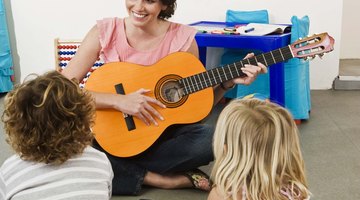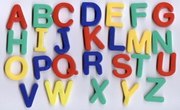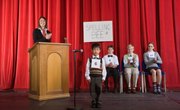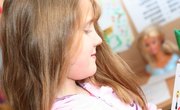Development of reading and writing skills is dependent upon gaining an understanding of both written and oral language. Before preschoolers are engaged in phonics activities -- which involve connecting speech sounds to print -- teachers should provide them with a strong foundation in phonological awareness. Good phonological awareness activities provide students with opportunities to build the listening and oral language skills necessary for reading and spelling development.
Matching Sounds
Preschool-aged children should be given opportunities to develop general listening and sound discrimination skills. Teachers can engage preschoolers in a sound-matching activity using common items and small, opaque containers. For this activity, teachers should create pairs of shakers that contain materials such as uncooked rice or beans, raw macaroni noodles, seeds or beads. During the activity, instructors present the sound shakers in random order. After children to pick up each shaker and listen to the sound, they can find the sets of shakers that make the same sound.
Rhyming Bingo
The ability to produce and identify rhyming words is part of phonological awareness. Rhyming bingo is one game of many that preschoolers can play to increase oral discrimination skills. Teachers can make their own rhyming bingo mats and cards using various pictures of words that rhyme, but a number of online teaching resources provide printable rhyming bingo materials as well. Played similar to traditional bingo, the teacher calls out a word and shows a picture instead of a number and letter. Students look for rhyming pictures on their mats until someone matches a certain number of pictures in a row.
Singing the Sounds
Word blending and segmenting skills are also included in phonological awareness. PALS, the state of Virginia’s screening tool for its Early Intervention Reading Initiative, recommends that teachers use a simple song to help children practice blending and segmenting sounds into words. Teachers should prepare picture cards featuring words that contain two or three sounds such as cat, fish, pen and bus. Using the tune of “The Wheels on the Bus,” instructors can engage students in singing verses of a song that identifies the sounds in each word. The song goes, “The sounds in the word go /c/ /a/ /t/, /c/ /a/ /t/, /c/ /a/ /t/. The sounds in the word go /c/ /a/ /t/. Can you guess the word?”
Clapping Syllables
Identifying the number of syllables in a word is another important skill included in phonological awareness. Teachers can lead students in a simple activity that requires them to clap each time they say a different syllable of a word and identify the total number of syllables. Using preschoolers' names during the activity encourages student engagement and interest. For example, children can sit in a circle and clap out the names of all of their friends. Teachers should highlight that words that sound longer usually contain more syllables.
Related Articles
References
Writer Bio
Based in Gainesville, Carissa Lawrence is an experienced teacher who has been writing education related articles since 2013. Lawrence holds a master's degree in early childhood education from the University of Florida.











